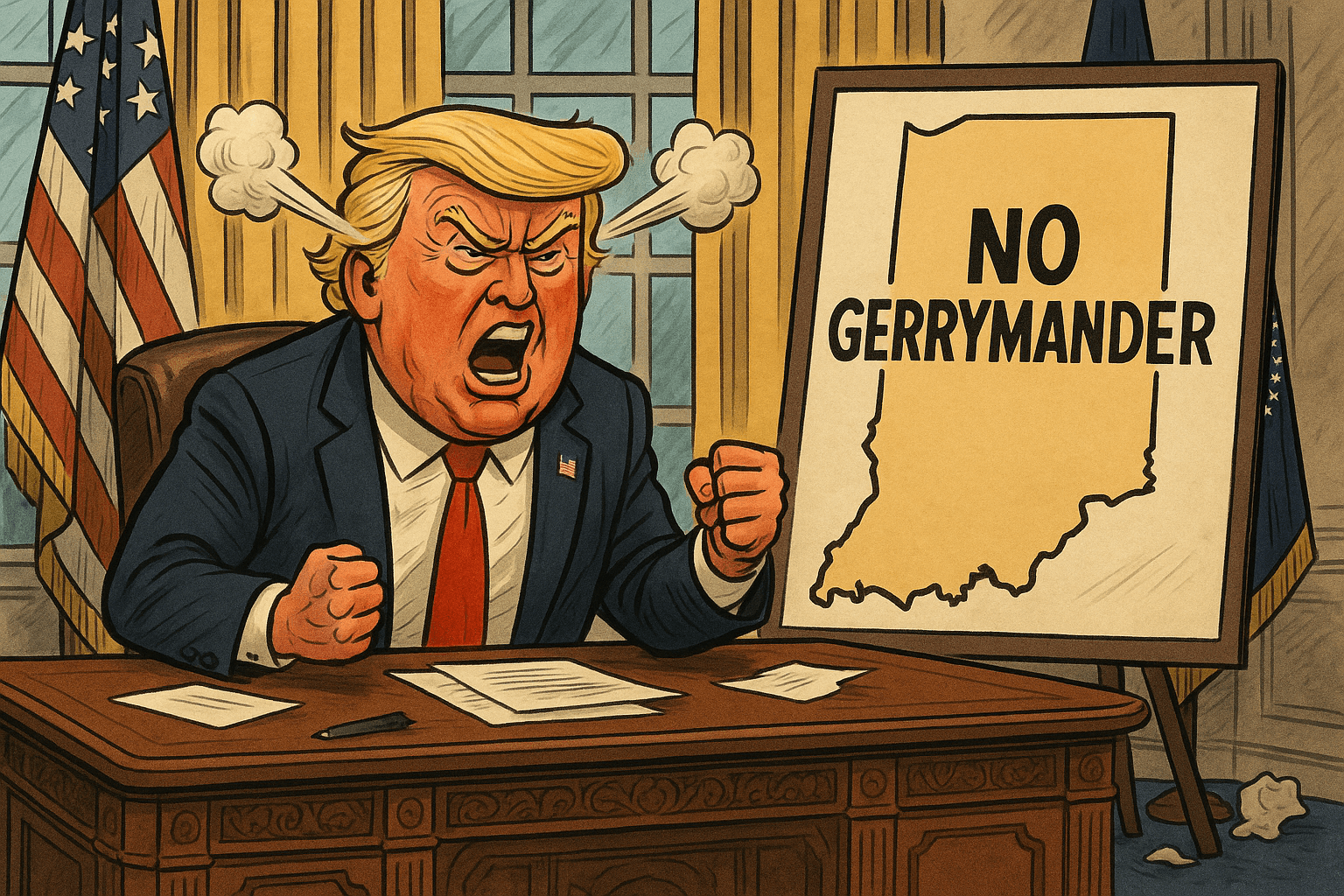Gerrymandering Wars Escalate Beyond Texas and California: A National Race to the Bottom?

Republicans currently hold a narrow 219-to-212 edge over Democrats in the U.S. House of Representatives, with four vacancies: three from Democratic members who have died and one from a Republican who has resigned. This is the smallest House majority held by either party in nearly a century. The razor-thin margin means the stakes in the 2026 midterms could not be higher. With so few competitive seats left nationwide, both parties are turning to mid-decade redistricting as a way to secure advantages.
The headlines are on Texas and California, where dueling plans could shift as many as ten seats. However, even if Republicans gain five seats in Texas and Democrats gain five in California, the net effect is an even swap.
The real story is that many more states are in play. Republicans control more state legislatures, and their path to additional seats is far wider than Democrats, who face complicated legal roadblocks in their few opportunities.
What is emerging is a race to the bottom that could lock in new partisan advantages and make the House even harder for Democrats to win back.
The likely outcome is even fewer competitive districts, deeper polarization, and a steady race to the bottom in American politics. And in the middle of the fight, independent voters — who make up a growing share of the electorate — are largely left out of the conversation, even though they are the ones caught in gerrymandered districts where their votes carry less weight.
It's no wonder that anti-gerrymandering crusader Katie Fahey of The People, is sounding the alarm.
“Right now instead of working as hard as they can to improve the economy, or figuring out the housing crisis, or focusing on any of the extremely pressing issues facing Americans, our government is arguing about how to best ignore the will of the voters in 2026 and beyond….an election still a year and a half away. Partisan redistricting, also known as “gerrymandering,” has led to some of the most ruthless, self-serving, and undemocratic politics in our country’s history, and the problem is about to get even worse.”
This week on the Independent Voter Podcast, we unpacked the partisan fight over gerrymandering and what we think it means for independent voters. We also discussed IVN’s recent story about national reformers who signed a letter opposing all gerrymandering everywhere, as well as IVN’s story about the 10 Worst Gerrymandered States in the Country.
Texas: Ground Zero for the Fight
Texas Republicans are pressing ahead with a mid-decade redraw that could add five GOP-leaning districts. The party currently holds 25 of the state’s 37 congressional seats, compared with 12 for Democrats. That number is expected to rise to 13 once a vacant Houston district is filled in November.
The targeted Democratic-held seats are:
- The 9th District near Houston, represented by Al Green
The 32nd District near Dallas, represented by Julie Johnson - The 35th District, stretching between San Antonio and Austin, is represented by Greg Casar
- The 34th District along the Gulf of Mexico, represented by Vicente Gonzalez, and
- The 28th District between the Rio Grande and San Antonio, represented by Henry Cuellar.
Republicans insist their plan is lawful. “The underlying goal of this plan is straightforward: improve Republican political performance,” said state Rep. Todd Hunter, who carried the bill in the Texas House. “According to the U.S. Supreme Court, you can use political performance, and that is what we have done.”
The GOP in Texas points to a 2019 Supreme Court ruling that removed federal courts from overseeing disputes about partisan gerrymandering.
Texas Democrats briefly denied Republicans a quorum by walking out and leaving the state, but returned after California Governor Gavin Newsom announced his state would mount a direct countermeasure.
With so much attention on the 2025 redistricting fight in Texas, the Independent Voter Project has received several inquiries into the registration numbers it has recorded on its popular state-by-state primary map. This makes sense – voters want to know what an accurate reflection of the Texas electorate looks like in the midst of a contentious redistricting fight.
However, the thing that surprises many people is that current figures show Democrats outnumber Republicans in Texas. This may seem strange considering how much control Republicans have in the state.
Total Registered Voters: 17,485,702
- Democrats: 8,133,683 (46.52%)
- Republicans: 6,601,189 (37.75%)
- Unaffiliated: 2,750,830 (15.73%)
California: Suspending the Gold Standard
California is preparing the mirror image of Texas. Governor Gavin Newsom wants to suspend the state’s independent citizen redistricting commission for five years, allowing Democrats to redraw the map. The proposal challenges one of the nation’s most celebrated reforms: in 2010, 60 percent of California voters approved a Schwarzenegger-backed initiative creating a nonpartisan commission. Reformers hailed it as the gold standard for fairness.
If Newsom’s plan advances, Democrats could target five Republican-held seats:
- The 3rd District, which runs along the Nevada border from Death Valley to Sacramento suburbs, is held by Kevin Kiley.
- The 1st District, in the northeast corner of the state, is held by Doug LaMalfa.
- The 41st District, which covers Palm Springs and the Coachella Valley, is represented by Ken Calvert.
- The 48th District, east of San Diego and into the Temecula Valley, is held by Darrell Issa.
- The 22nd District in the San Joaquin Valley, including parts of Bakersfield, is held by David Valadao.
If Democrats win all five, they would hold 48 of the state’s 52 seats, leaving Republicans with just four.
Common Cause, a long-time leading advocate against partisan gerrymandering, has taken a cautious approach. “We affirm that gerrymandering, both racial and political, disenfranchises voters,” said Virginia Kase Solomón, president and CEO. However, she added that the group will judge California’s plan by whether it is a proportional response to GOP actions, whether it includes public participation, and whether any new maps expire after the 2030 census, thereby returning power to the commission.
In any case, as IVN recently reported, Californians, especially independents, might not be so eager to hand politicians the keys to redistricting again. A brand new Citrin Center / UC Berkeley Possibility Lab / POLITICO poll shows independents oppose Newsom’s plan by a nearly three-to-one margin. Seventy-two percent (72%) want to keep the independent redistricting commission. Only 28% are willing to let the Legislature take back control of congressional map drawing.
Democratic States Testing Limits
Outside California, Democrats have at least three potential opportunities — but each faces steep legal barriers.
- New York: Governor Kathy Hochul is working with legislative leaders to explore all options, but the state constitution bars a full mid-decade redraw until 2028. House Minority Leader Hakeem Jeffries told CNN’s Dana Bash on August 26 that there is a plan “to respond as appropriately in New York and in other parts of the country as the circumstances dictate,” but gave no details. Asked if Republican gains elsewhere could block Democrats from retaking the House, Jeffries replied, “Not at all.”
- Illinois: Governor JB Pritzker already presides over a 14-to-3 Democratic advantage. He has signaled his willingness to extend partisan advantage even further, saying "everything has to be on the table."
- Maryland: Governor Wes Moore suggested on Face the Nation that he will redraw his state’s maps, but in 2022, the state’s highest court struck down an 8-to-0 map for Maryland and imposed strict limits going forward.
Together, these states could theoretically add a few seats for Democrats, but their legal paths are far narrower than those for Republicans.
Ohio: A Forced Redraw with High Stakes
One of the most consequential fights is in Ohio, where a citizen initiative and a protracted Supreme Court battle actually require a new map before the end of the year. Republicans currently hold a 10-to-5 advantage in the state’s delegation. Some party leaders believe it could become a 12-to-3 split through Republican gerrymandering.
The likeliest Democratic targets are:
- The 13th District, covering Akron, Canton, and southern Cleveland suburbs, is represented by Emilia Sykes.
- The 9th District, anchored in Toledo, is represented by Marcy Kaptur.
Because voters themselves have mandated the redraw, it is sure to happen. How far Republicans go in pressing their advantage will be a national flashpoint.
Missouri: Special Session Momentum
In Missouri, Republican leaders are preparing to act quickly. After President Trump wrote on Truth Social that Missouri “is IN” to redraw its eight districts, Governor Mike Kehoe’s office said leaders are reviewing options to “best represent Missourians.” The target is clear: Representative Emanuel Cleaver, a Democrat who has represented the Kansas City-based 5th District for nearly two decades.
Indiana: A Divided GOP
In Indiana, Republicans currently hold a 7-to-2 advantage. Despite pressure from the White House, legislators remain split over whether to reopen the maps. If they do, the most likely target is Frank Mrvan in the 1st District in the northwest. In a more aggressive scenario, they could also target André Carson in the 7th District, which encompasses Indianapolis.
Florida and Beyond
In Florida, Republicans are considering another redistricting effort after securing gains in the last election cycle. Other GOP-controlled states being discussed include Kansas, Kentucky, Georgia, Tennessee, North Carolina, and New Hampshire.
President Donald Trump has linked these efforts to a larger strategy.
On Aug. 20, he wrote on Truth Social that Texas’s push is just one part of his plan for a Republican congressional supermajority. “Florida, Indiana, and others are looking to do the same,” he said. If those efforts succeed, and if mail-in voting is eliminated, he claimed Republicans could “pick up 100 more seats, and the CROOKED game of politics is over.”
No Federal Law to Stop Gerrymandering Exists
While state legislatures control redistricting in 39 states, there are few federal limits on the process. This, despite national polls showing wide majorities of voters oppose partisan gerrymandering and believe it should be illegal. Yet federal law does not prohibit it.
States with independent commissions that limit gerrymandering, such as California, Michigan, and Arizona, have these commissions because voters themselves have risen up against the politicians to enact initiatives to create them.
The Justice Department has also entered the fight, alleging that several Texas districts were unconstitutional racial gerrymanders. Those under review include Al Green’s 9th, Sylvia Garcia’s 29th, and the district formerly held by Sylvester Turner, which remains vacant after Governor Abbott delayed the special election to fill it.
Separately, a pending Supreme Court case from Louisiana could reshape minority-majority districts across the South if protections under the Voting Rights Act are narrowed.
In Utah, the jury is still out. IVN’s Shawn Griffiths reported that on August 25, a judge rejected Republican attempts to strike down an anti-gerrymandering citizens’ initiative.
National Stakes
Even if California and Texas cancel each other out, Republican moves in different states could yield an additional six or seven GOP seats. That would widen their current edge and make the House even more difficult for Democrats to win back. Analysts estimate Democrats would then need to flip at least nine to twelve competitive districts in 2026. In 2024, only 37 races nationwide were decided by five points or less.
Republicans Have Been Playing the Long Game
Much of today’s map can be traced back to the GOP’s Redistricting Majority Project, or REDMAP, which was launched in 2010. By investing $30 million in targeted state legislative races, Republicans flipped chambers in swing states and drew more than 190 congressional districts favorable to their party, compared to about 40 for Democrats. That advantage still shapes the battlefield.
What was once a once-per-decade exercise is now evolving into a rolling series of partisan battles. California and Texas may cancel each other out, but Republicans control more legislatures, giving them more open paths and more seats to play with. Democrats in New York, Illinois, and Maryland face complicated legal roads that limit their ability to respond in kind.
The 2030 census is expected to deepen the trend toward Republican districts. Population shifts will likely cost California and New York several seats, while adding representation in Republican-leaning states such as Texas, Florida, Georgia, and North Carolina.
 Cara Brown McCormick
Cara Brown McCormick







